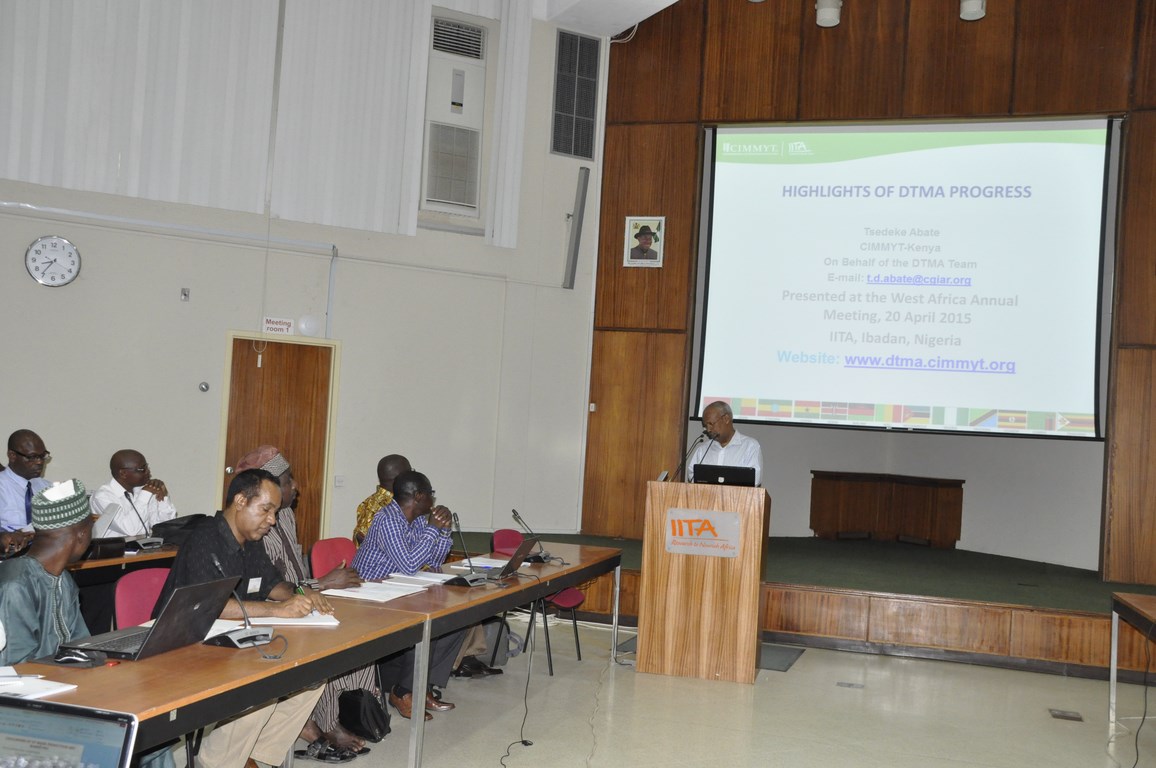The Drought Tolerant Maize for Africa (DTMA) project has completely lived through its implementation phases and is on course to be replaced by a new project known as Stress Tolerant Maize for Africa (STMA). From 2016 onwards, DTMA will have a new shape and form. Although this is still in the proposal stage, STMA is set to replicate the successes achieved in DTMA across sub-Saharan Africa and to also deploy novel technologies that will better create desired impacts.

Dr Tsedeke Abate sheds light on the progress of the DTMA project and projected expectations for STMA.
On 20-21 April at the Conference Center in Ibadan, Nigeria, stakeholders involved in the implementation of DTMA from 2007 to 2013 convened to review progress in the last 8-9 years of implementation, discuss outputs, outcomes, sustainability models, and the next steps for the future.
Dr Ylva Hillbur, DDG Research for Development, welcomed the DTMA team to the work plan meeting, stressing that the importance of their work in sub-Saharan Africa could not be overestimated. She hailed the project, describing it as proactive.
“In particular,” she said, “the extra-early maize variety which bears appealing morphological, aesthetic, and yield characteristics always sells the story of success from the DTMA project… DTMA has strong partnerships and networks that make the difference between projects with long-lasting impacts. DTMA has proven that more than developing new varieties, it is important to integrate farmers within the system and encourage them to grow those varieties.”
Dr Tsedeke Abate, DTMA project leader, recounts that the DTMA project has done a tremendous job in breeding new maize varieties that can replace old varieties, give high yield, and possess other desirable agronomic traits such as drought tolerance, resistance to Maize Streak Virus and to Striga.
“…The result across sub-Saharan Africa for farmers growing DTMA varieties is very encouraging,” he said. Apart from developing more than 200 hybrid and open-pollinated varieties (OPVs) of maize, more than 50% of plots planted to maize in 2013 in Nigeria are also DTMA varieties.
“In the beginning, we set out to develop more than 200 hybrids and OPVs
and deliver 60,000 t of maize seeds,” he said. “So far, we can proudly say that
we have been successful in developing the varieties we said we would, and
we are still on track to meet our target in the area of delivering certified DTMA seeds.”
Dr Tsedeke also called on partners to intensify efforts in the distribution of the varieties already released to ensure that farmers get unlimited access to new and better varieties.
“To facilitate this, DTMA will continue among others to encourage national programs in target countries to promote DTMA materials across Africa and empower partners to scale out materials developed by the project,” he added.
More about STMA
For lasting and sustainable impacts on the ground, STMA will be implemented by IITA and the International Maize and Wheat Improvement Centre (CIMMYT) under two key components. The first is Improved Maize for African Soils (IMAS) – aimed to find maize varieties having high nitrogen use efficiency and addressing the issues of abiotic stresses of the crop. The second component is the Drought Tolerant Maize for Africa Seed Scaling (DTMAS) – aimed to scale up the seed varieties so far released under DTMA.
“The general idea for the new project is to ensure that the new maize varieties already developed will be widely used,” explained Dr Tsedeke.
DTMAS is now being piloted in seven countries in Southern and Eastern Africa; Ethiopia, Kenya, Tanzania, Uganda, Malawi, Mozambique, and Zambia. It is also very likely that DTMAS will be piloted in critical countries in West Africa as well.
On why the project has a good potential to succeed, Dr Tsedeke explained, “STMA is more on the supply side of research and technologies which is a major constraint for agriculture today. DTMAS, on the other hand, is essentially about taking out the technologies and working with farmers.”
“We are promoting a new generation of maize varieties to keep pace with and address climate changes and meet the future needs of maize farmers and agriculture,” Dr Tsedeke added.
Specifically, the broad areas for focus in implementing STMA are storage/postharvest practices for maize, breeding, and scaling up of released maize varieties.
The new challenge will be to eradicate the new disease — Maize Lethal Necrosis — a really big threat for African agriculture which is now widely spread in Ethiopia, Tanzania, Uganda, Rwanda, and Southern Sudan.
To achieve this, STMA will work with several universities and institutions in Africa, Germany, and North America, and deploy double haploid technology to eradicate the disease from farmers’ fields.

No Comments